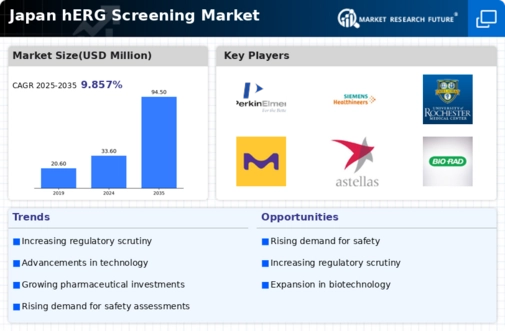Stringent Regulatory Framework
Japan's regulatory environment plays a pivotal role in shaping the herg screening market. The Pharmaceuticals and Medical Devices Agency (PMDA) enforces rigorous guidelines for drug approval, emphasizing the importance of cardiac safety. These regulations require comprehensive herg screening to assess the potential for drug-induced arrhythmias. As a result, pharmaceutical companies are increasingly adopting herg screening as a standard practice in their development pipelines. The stringent regulatory framework not only ensures patient safety but also drives demand for advanced screening technologies and services, thereby propelling the growth of the herg screening market.
Growing Awareness of Drug Safety
There is a notable increase in awareness regarding drug safety among healthcare professionals and patients in Japan. This heightened awareness is largely driven by the dissemination of information regarding the risks associated with cardiac side effects of medications. As patients become more informed, they are more likely to demand assurances of safety from healthcare providers. Consequently, pharmaceutical companies are compelled to prioritize herg screening in their drug development processes to meet these expectations. This trend indicates a shift towards a more safety-conscious approach in the herg screening market, as stakeholders recognize the importance of addressing potential cardiac risks.
Rising Incidence of Cardiac Disorders
The increasing prevalence of cardiac disorders in Japan is a crucial driver for the herg screening market. As the population ages, the incidence of conditions such as arrhythmias and heart failure rises, necessitating effective screening methods. According to recent health statistics, approximately 20% of the Japanese population is expected to be over 65 years by 2030, which correlates with a higher demand for cardiac safety assessments. This demographic shift compels pharmaceutical companies to prioritize herg screening in drug development processes, ensuring that new therapies do not pose risks of cardiac toxicity. Consequently, the herg screening market is likely to experience growth as stakeholders seek to mitigate potential health risks associated with new medications.
Increased Investment in Pharmaceutical R&D
Japan's robust pharmaceutical research and development (R&D) sector significantly influences the herg screening market. The government has been actively promoting innovation through various funding initiatives, which has led to an increase in R&D expenditures. In 2025, the pharmaceutical industry in Japan is projected to invest over ¥1 trillion in R&D, with a substantial portion allocated to safety assessments, including herg screening. This investment is essential for ensuring that new drugs meet stringent safety standards before reaching the market. As a result, the herg screening market is poised for expansion, driven by the need for comprehensive safety evaluations in drug development.
Technological Innovations in Screening Techniques
The herg screening market is experiencing a transformation due to technological innovations in screening techniques. Advances in high-throughput screening methods and in silico modeling are enhancing the efficiency and accuracy of herg assessments. In Japan, research institutions and biotech companies are increasingly adopting these technologies to streamline the drug development process. For instance, the integration of artificial intelligence in predictive modeling is expected to improve the identification of cardiac risks associated with new compounds. This technological evolution not only accelerates the screening process but also contributes to the overall growth of the herg screening market, as it enables more reliable safety evaluations.






















Leave a Comment